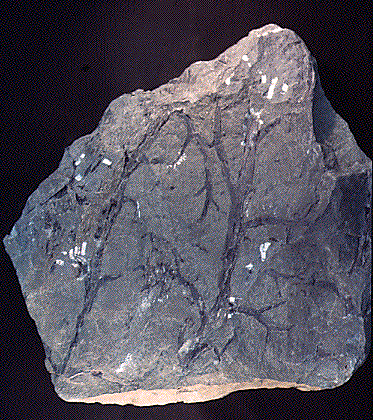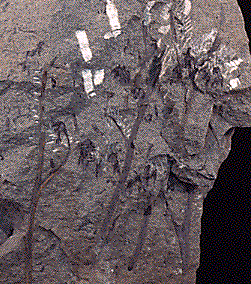

A number of fossil vascular plants of the Devonian are superficially similar to the "rhyniophytes" but show some features not found in the rhyniophytes. These plants are grouped together in the Trimerophytophyta, the "trimerophytes." This group is almost certainly paraphyletic; that is, it does not include all the descendants of a common ancestor. Nonetheless, trimerophytes are of great evolutionary interest, because they include fossils that are close to the common ancestry of prominent plant taxa, such as ferns, progymnosperms, and sphenophytes. The trimerophytes appear to form a sort of basal group close to the ancestry of these major taxa.
Like the rhyniophytes, trimerophytes lacked leaves and roots; most of the plant body consisted of branching stems that were photosynthetic throughout their length. Vascular tissue was present, forming a solid central bundle in the center of the stem, or protostele. However, whereas rhyniophytes branched dichotomously -- stems always branched into two equal branches -- trimerophytes branched pseudomonopodially, which is a way of saying that branching was unequal, forming a main stem, or axis, with several smaller lateral branches. You can see this pattern of branching in the picture of Psilophyton forbesii, at right. Lateral branches typically branched dichotomously, and were often shortened to form bushy "webs" of small, closely spaced branches. Some trimerophytes also bore enations -- small flaps of tissue lacking vascularization, and therefore not true leaves -- on the main stems, giving them a superficially "thorny" appearance.
Like the rhyniophytes, but unlike the superficially similar zosterophylls from the same time period, trimerophytes bore sporangia at the tips of branches. The spindle-shaped sporangia produced only one type of spore: trimerophytes were thus homosporous. Spores released from the sporangia would have germinated into gametophytes, but no fossil trimerophytes gametophytes have been identified, and we do not know whether trimerophytes, like their later relatives the ferns, sphenopsids, and seed plants, had small, inconspicuous gametophytes.
Trimerophytes varied in size from a few centimeters to nearly a meter tall; large trimerophytes were among the largest plants of the Early Devonian. One of the meter-high trimerophytes, Pertica quadrifaria, has attained some post-extinction fame as the state fossil of Maine. Another species in this genus is pictured below.



